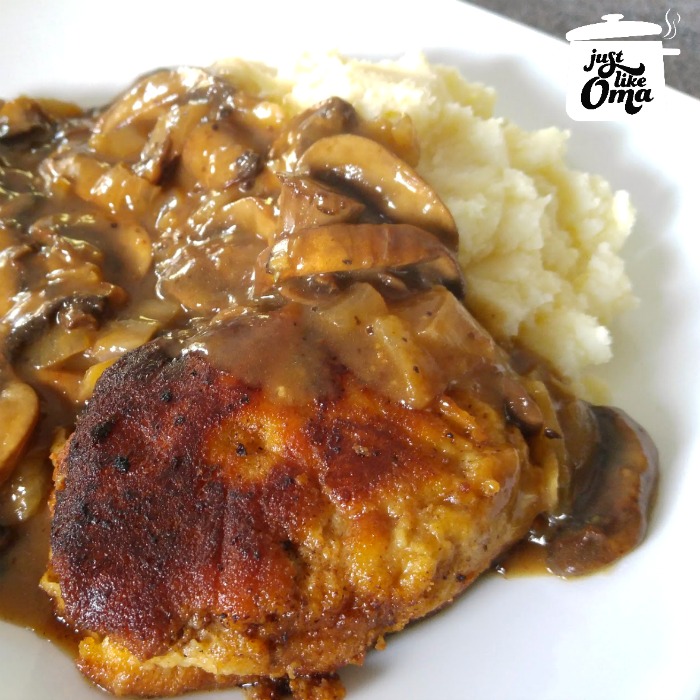Oma's Breaded Pork Chops

This breaded pork chops recipe, aka Schweinekotelett, is among the tastiest and quickest dinner meal ideas you can have. This is a simple one, one that always turns out juicy and delicious! Once you learn the basics of how to cook pork chops, there are so many little variations that you can make. Just adding extra herbs and spices can make a dramatic change.
I'll often make an extra chop or two. They taste so great cold and sliced in a sandwich for lunch the next day. Wunderbar!
Ingredients:4 pork chops, trimmed of fat, with or without bone
1½ cups bread crumbs
1 egg
¾ tsp Seasoning Salt, see hints below
olive oil and butter for frying
Instructions:
Mix egg and 1 Tbsp water in a flat soup bowl.
Mix bread crumbs and Seasoning Salt in another flat soup bowl.
If the pork chops have fat along the edge, remove the excess. Then cut into any remaining fat (slash from the other edge of the chop through the fat) to prevent the meat from curling when cooking.
Heat on high about 2 Tbsp olive oil (or butter) in a large flat-bottomed frying pan, enough just to cover the bottom.
Take first pork chop and coat with bread crumbs, then dip in egg mixture, then re-coat with more bread crumbs. Carefully place into frying pan so that it doesn't splatter. Repeat with remaining chops. Add extra butter or oil if needed.
Turn chops when nicely browned on one side.
Cover frying pan and lower heat to gently continue browning and cooking the chops until done. Turn once or twice during cooking. One-inch thick chops will take about 20 minutes.
HintsI usually use an oil/butter mixture. Pure butter tastes great, but adding the olive oil makes it a bit healthier. If you prefer, just use oil. If you are using pure butter, be careful that the chops don't burn.
The Seasoning Salt I like is a "no-name" brand. Use any that you like, or just use salt and pepper to season.
Add Parmesan cheese to bread crumbs or other herbs of your choice to vary recipe.
I'll often make an extra chop or two. They taste so great cold and sliced in a sandwich for lunch the next day. Wunderbar!
Oma's Breaded Pork Chops❤️
Ingredients:4 pork chops, trimmed of fat, with or without bone
1½ cups bread crumbs
1 egg
¾ tsp Seasoning Salt, see hints below
olive oil and butter for frying
Instructions:
Mix egg and 1 Tbsp water in a flat soup bowl.
Mix bread crumbs and Seasoning Salt in another flat soup bowl.
If the pork chops have fat along the edge, remove the excess. Then cut into any remaining fat (slash from the other edge of the chop through the fat) to prevent the meat from curling when cooking.
Heat on high about 2 Tbsp olive oil (or butter) in a large flat-bottomed frying pan, enough just to cover the bottom.
Take first pork chop and coat with bread crumbs, then dip in egg mixture, then re-coat with more bread crumbs. Carefully place into frying pan so that it doesn't splatter. Repeat with remaining chops. Add extra butter or oil if needed.
Turn chops when nicely browned on one side.
Cover frying pan and lower heat to gently continue browning and cooking the chops until done. Turn once or twice during cooking. One-inch thick chops will take about 20 minutes.
HintsI usually use an oil/butter mixture. Pure butter tastes great, but adding the olive oil makes it a bit healthier. If you prefer, just use oil. If you are using pure butter, be careful that the chops don't burn.
The Seasoning Salt I like is a "no-name" brand. Use any that you like, or just use salt and pepper to season.
Add Parmesan cheese to bread crumbs or other herbs of your choice to vary recipe.
Source link from : https://www.quick-german-recipes.com/breaded-pork-chop-recipes.html
BERITA LENGKAP DI HALAMAN BERIKUTNYA
Halaman Berikutnya